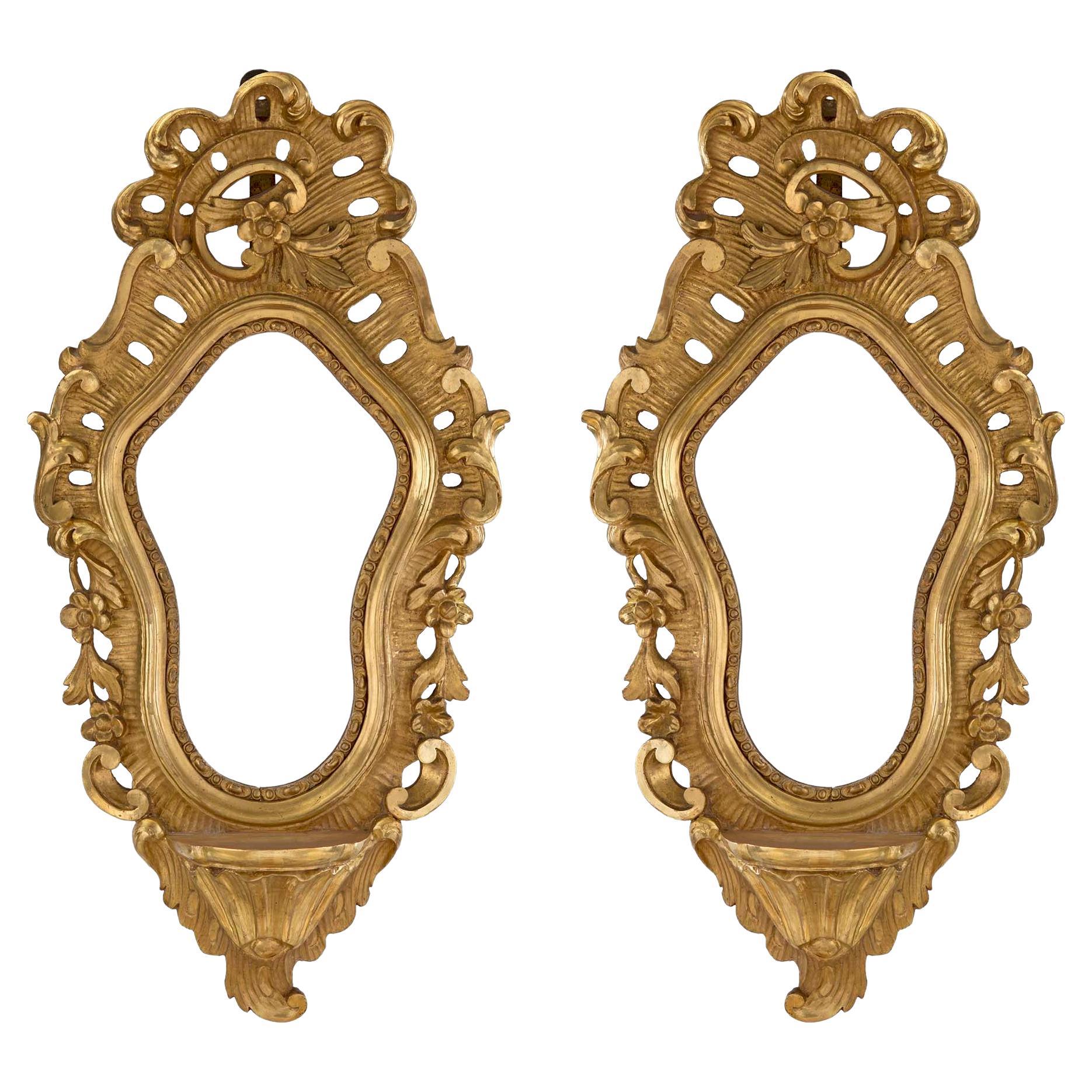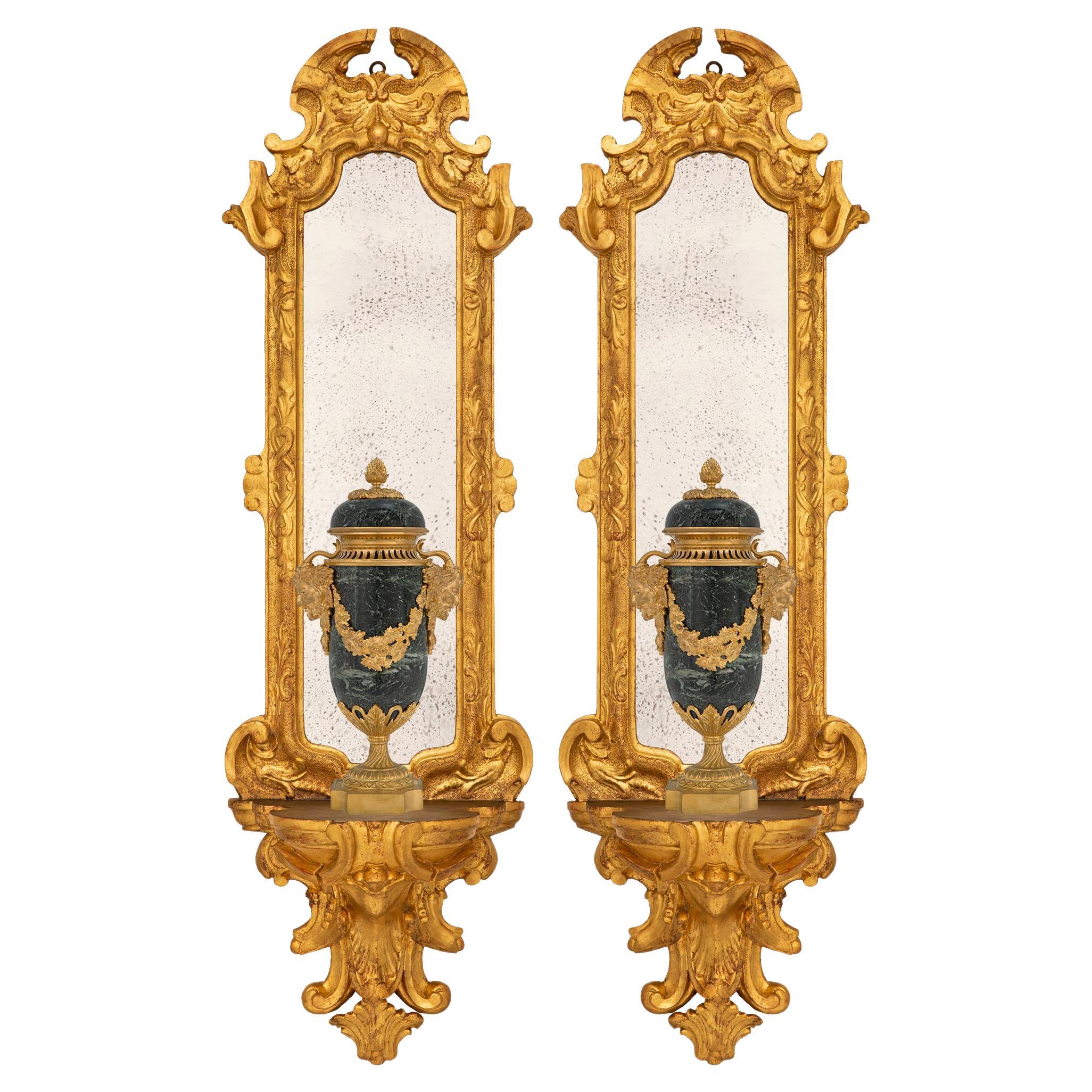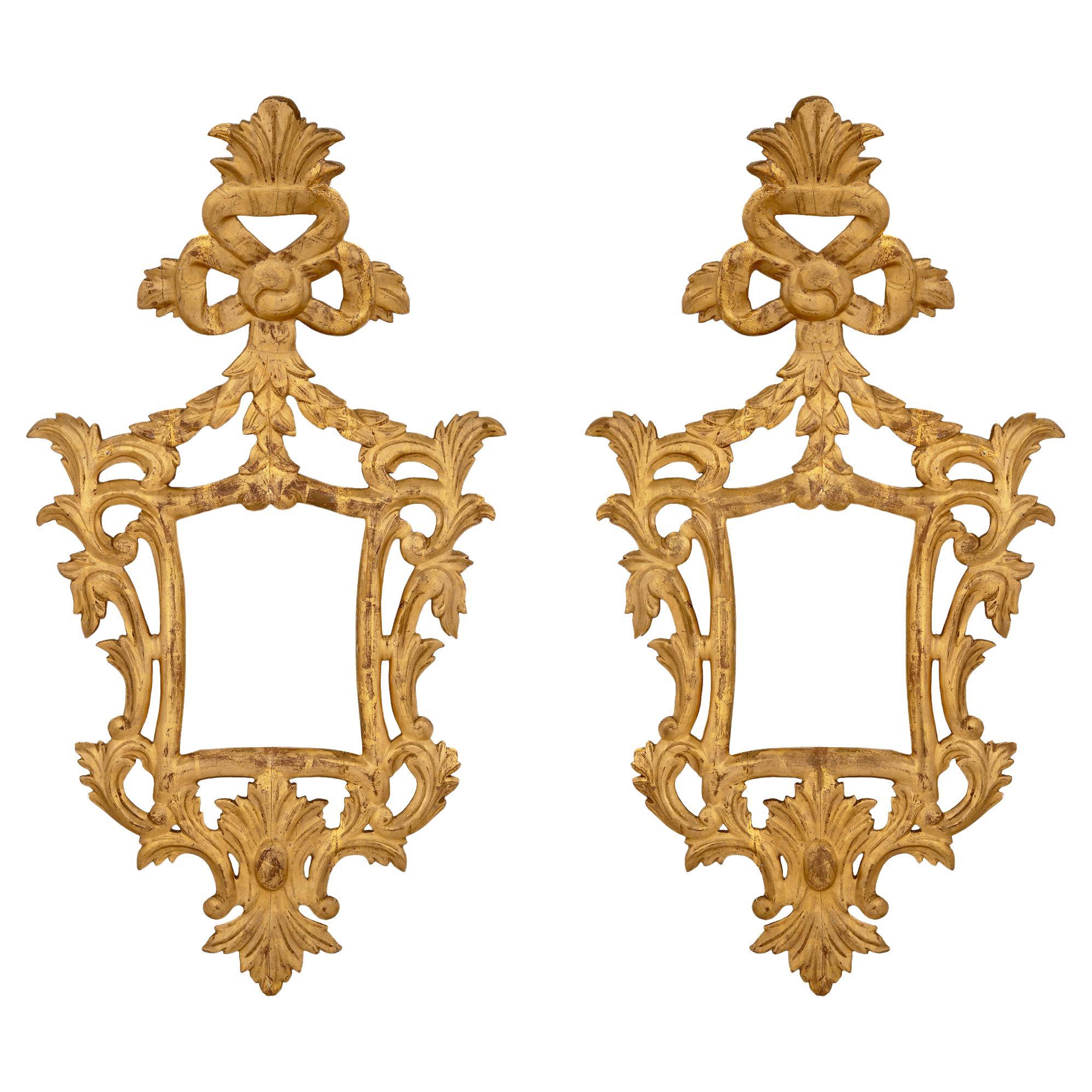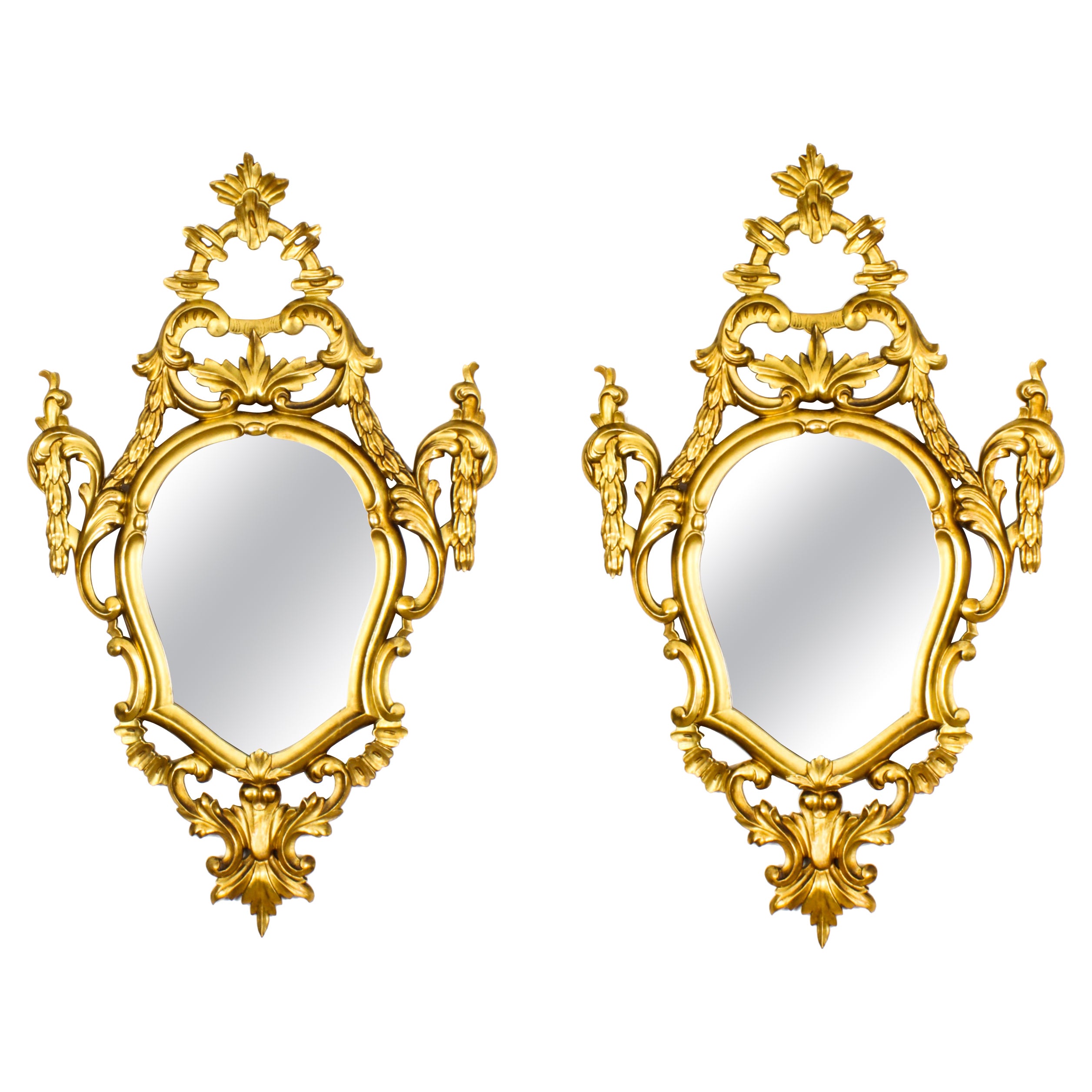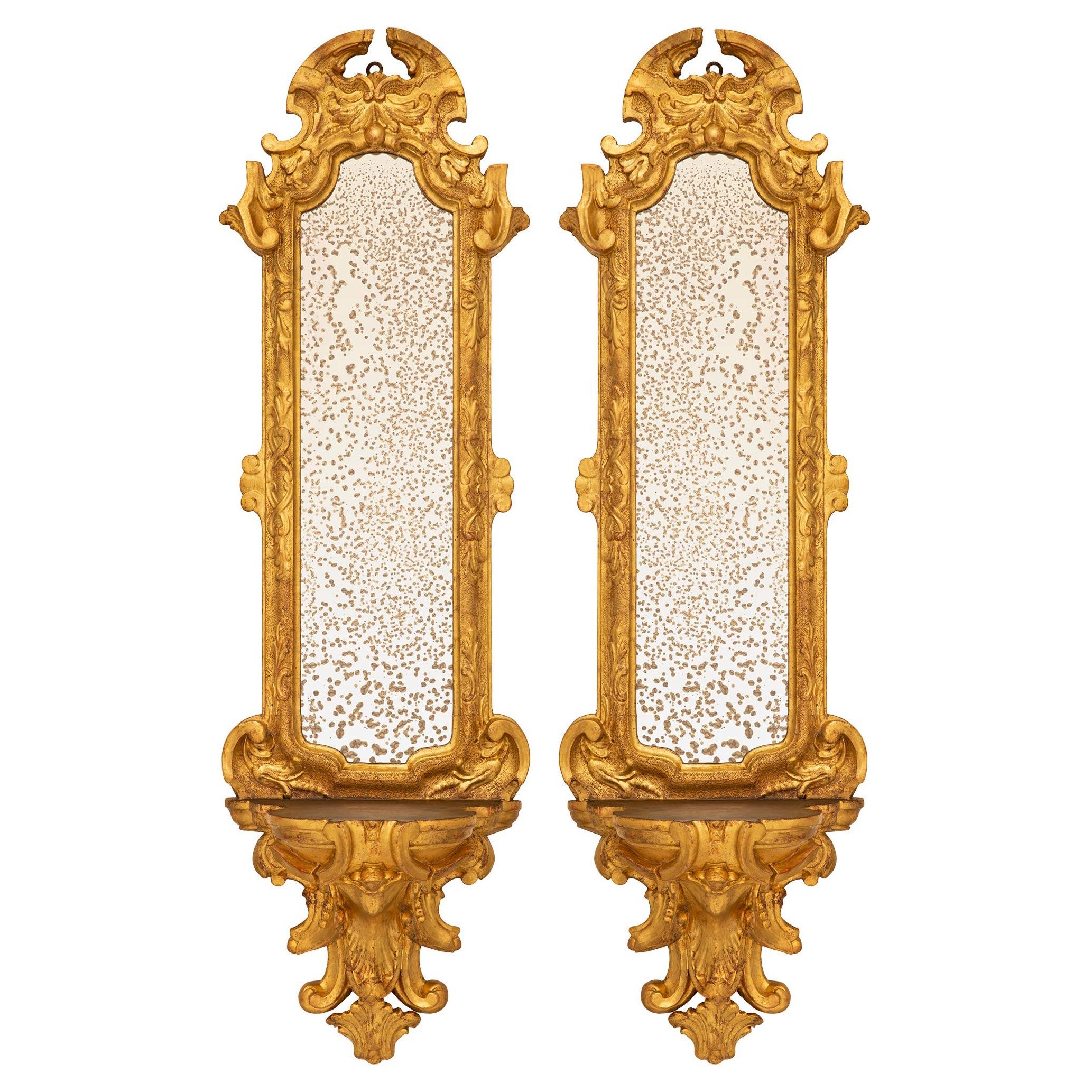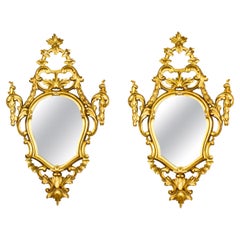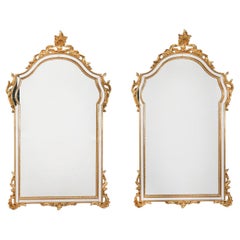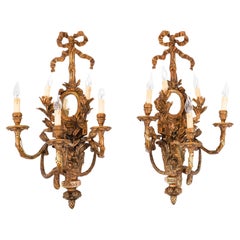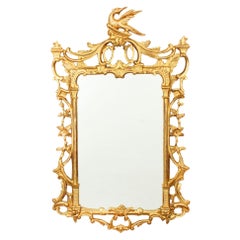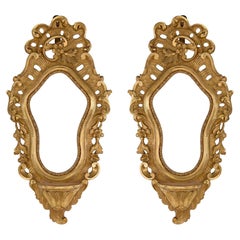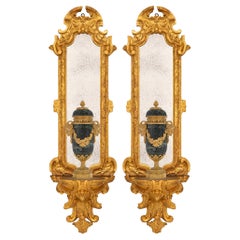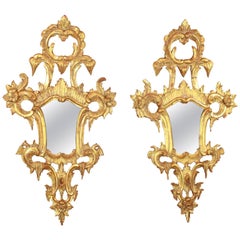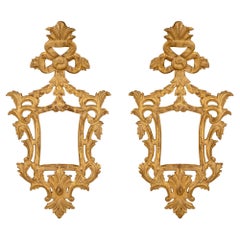Items Similar to Antique Pair Rococo Giltwood Mirrored Wall Brackets 19th Century
Want more images or videos?
Request additional images or videos from the seller
1 of 12
Antique Pair Rococo Giltwood Mirrored Wall Brackets 19th Century
$3,748.04
£2,750
€3,224.54
CA$5,170.74
A$5,750.08
CHF 3,020.07
MX$70,300.49
NOK 37,632.92
SEK 35,477.68
DKK 24,065.46
About the Item
An elegant pair of giltwood Rococo revival mirrored wall brackets, circa 1880 in date.
They feature stylized shell crests above two shelves with cartouche apron,
boldly-carved scrolling acanthus frame, and they retain the original gilding.
This impressive pair is certain to make a charming addition to that one special room in your home, and are ideal for displaying your precious objets d'art.
Condition:
In excellent condition having been beautifully cleaned and waxed in our workshops, please see photos for confirmation.
Dimensions in cm:
Height 86 cm x Width 42 cm x Depth 21 cm
Dimensions in inches:
Height 2 foot, 10 inches x Width 1 foot, 4 inches x Depth 8 inches
Rococo
Although Rococo is usually thought of as developing first in the decorative arts and interior design, its origins lie in the late Baroque architectural work of Borromini (1599–1667) mostly in Rome and Guarini (1624–1683) mostly in Northern Italy but also in Vienna, Prague, Lisbon, and Paris. Italian architects of the late Baroque/early Rococo were wooed to Catholic (Southern) Germany, Bohemia and Austria by local princes, bishops and prince-bishops. Inspired by their example, regional families of Central European builders went further, creating churches and palaces that took the local German Baroque style to the greatest heights of Rococo elaboration and sensation.
An exotic but in some ways more formal type of Rococo appeared in France where Louis XIV's succession brought a change in the court artists and general artistic fashion. By the end of the king's long reign, rich Baroque designs were giving way to lighter elements with more curves and natural patterns. These elements are obvious in the architectural designs of Nicolas Pineau. During the Régence, court life moved away from Versailles and this artistic change became well established, first in the royal palace and then throughout French high society.
An exotic but in some ways more formal type of Rococo appeared in France where Louis XIV's succession brought a change in the court artists and general artistic fashion. By the end of the king's long reign, rich Baroque designs were giving way to lighter elements with more curves and natural patterns. These elements are obvious in the architectural designs of Nicolas Pineau. During the Régence, court life moved away from Versailles and this artistic change became well established, first in the royal palace and then throughout French high society.
The delicacy and playfulness of Rococo designs is often seen as perfectly in tune with the excesses of Louis XV's reign.
The 1730s represented the height of Rococo development in France. The style had spread beyond architecture and furniture to painting and sculpture, exemplified by the works of Antoine Watteau and François Boucher. Rococo still maintained the Baroque taste for complex forms and intricate patterns, but by this point, it had begun to integrate a variety of diverse characteristics, including a taste for Oriental designs and asymmetric compositions. The Rococo style was spread by French artists and engraved publications.
In Great Britain, Rococo was always thought of as the "French taste" and was never widely adopted as an architectural style, although its influence was strongly felt in such areas as silverwork, porcelain, and silks, and Thomas Chippendale transformed British furniture design through his adaptation and refinement of the style. William Hogarth helped develop a theoretical foundation for Rococo beauty. Though not intentionally referencing the movement, he argued in his Analysis of Beauty (1753) that the undulating lines and S-curves prominent in Rococo were the basis for grace and beauty in art or nature (unlike the straight line or the circle in Classicism). The development of Rococo in Great Britain is considered to have been connected with the revival of interest in Gothic architecture early in the 18th century.
Our reference: A4420
- Dimensions:Height: 33.86 in (86 cm)Width: 16.54 in (42 cm)Depth: 8.27 in (21 cm)
- Style:Rococo Revival (In the Style Of)
- Materials and Techniques:
- Period:
- Date of Manufacture:circa 1880
- Condition:
- Seller Location:London, GB
- Reference Number:Seller: A44201stDibs: LU950644069782
About the Seller
5.0
Platinum Seller
Premium sellers with a 4.7+ rating and 24-hour response times
Established in 1983
1stDibs seller since 2012
1,389 sales on 1stDibs
Typical response time: <1 hour
Associations
LAPADA - The Association of Arts & Antiques Dealers
- ShippingRetrieving quote...Shipping from: London, United Kingdom
- Return Policy
Authenticity Guarantee
In the unlikely event there’s an issue with an item’s authenticity, contact us within 1 year for a full refund. DetailsMoney-Back Guarantee
If your item is not as described, is damaged in transit, or does not arrive, contact us within 7 days for a full refund. Details24-Hour Cancellation
You have a 24-hour grace period in which to reconsider your purchase, with no questions asked.Vetted Professional Sellers
Our world-class sellers must adhere to strict standards for service and quality, maintaining the integrity of our listings.Price-Match Guarantee
If you find that a seller listed the same item for a lower price elsewhere, we’ll match it.Trusted Global Delivery
Our best-in-class carrier network provides specialized shipping options worldwide, including custom delivery.More From This Seller
View AllAntique Pair Florentine Rococo Giltwood Mirrors 19th Century
Located in London, GB
This is a superb pair of antique Italian Florentine giltwood mirrors, circa 1870 in date.
The oval mirrors plates are set within a Rococo boldly-carved scrolling acanthus frame, and they retain the original gilding.
Florentine style refers to the art and architecture coming out of Florence, Italy during the Renaissance period. Florentine furniture is characterized by the heavy use of gold gilding on wood and very elaborate hand carved decoration.
This impressive pair is certain to make a charming addition to that one special room in your home.
Condition:
In excellent condition having been beautifully cleaned and waxed in our workshops, please see photos for confirmation.
Dimensions in cm:
height 102 x width 63 x depth 4
Dimensions in inches:
height 3 foot, 4 inches x width 2 feet, 1 inch x depth 2 inches
Rococo
Although Rococo is usually thought of as developing first in the decorative arts and interior design, its origins lie in the late Baroque architectural work of Borromini (1599–1667) mostly in Rome and Guarini (1624–1683) mostly in Northern Italy but also in Vienna, Prague, Lisbon, and Paris. Italian architects of the late Baroque/early Rococo were wooed to Catholic (Southern) Germany, Bohemia and Austria by local princes, bishops and prince-bishops. Inspired by their example, regional families of Central European builders went further, creating churches and palaces that took the local German Baroque style to the greatest heights of Rococo elaboration and sensation.
An exotic but in some ways more formal type of Rococo appeared in France where Louis XIV's succession brought a change in the court artists and general artistic fashion. By the end of the king's long reign, rich Baroque designs were giving way to lighter elements with more curves and natural patterns. These elements are obvious in the architectural designs of Nicolas Pineau. During the Régence, court life moved away from Versailles...
Category
Antique 1870s Italian Rococo Wall Mirrors
Materials
Mirror, Giltwood
Vintage Pair Symmetrical Giltwood Mirrors 107x61cm Mid 20th Century
Located in London, GB
Vintage English pair of Symmetrical Giltwood Mirrors Mid-20th Century in date.
The carved and gilded, shaped rectangular frames are adorned with acanthus detailing and crowned with ...
Category
Mid-20th Century English Wall Mirrors
Materials
Giltwood
Vintage Monumental Pair Ormolu Twin Branch Wall Lights Sconces mid 20th Century
Located in London, GB
This is a monumental French pair of antique Louis XVI Revival gilded ormolu quadruple branch wall lights, mid-20th century in date.
A large pair of very ormolu wall sconces, each w...
Category
Mid-20th Century French Louis XIV Wall Lights and Sconces
Materials
Ormolu
Antique French Decorative Giltwood Mirror 19th Century 127 x 77cm
Located in London, GB
This is a lovely and very decorative French Rococo Revival giltwood mirror, circa 1880 in date.
This mirror is richly carved with phoenix cresting to the top sides and bottom flanked by foliate acanthus rococo...
Category
Antique 1880s French Rococo Revival Wall Mirrors
Materials
Giltwood
Vintage Monumental Italian Rococo Giltwood Decorative Mirror 20th Century
Located in London, GB
This is a finely hand carved monumental Italian Rococo Revival giltwood mirror, dating from the late 20th century.
It features a large exaggerated central multi directional pieced...
Category
Vintage 1980s Italian Rococo Revival Wall Mirrors
Materials
Mirror, Giltwood
Antique Ormolu & Sevres Porcelain Twin Branch Wall Light Sconces 19th C
Located in London, GB
This is a stunning Antique Sevres porcelain and ormolu wall light, Circa 1850 in date.
It features an elegant classical frame topped with a ribbon crest with a satyr mask below a...
Category
Antique 1850s Wall Lights and Sconces
Materials
Ormolu
You May Also Like
Pair of Italian 19th Century Baroque Mirrored Giltwood Wall Bracket
Located in West Palm Beach, FL
A stunning pair of Italian 19th century Baroque mirrored giltwood wall brackets. The finely carved wall brackets have a shelf at t...
Category
Antique 19th Century Italian Baroque Wall Mirrors
Materials
Mirror, Giltwood
A pair of Italian 17th century Baroque period Giltwood mirrored wall brackets.
Located in West Palm Beach, FL
A stunning and finely detailed pair of Italian 17th century Baroque period Giltwood mirrored wall brackets. Each wall bracket is centered by an impressive richly carved bottom foliat...
Category
Antique 17th Century Italian Baroque Wall Mirrors
Materials
Giltwood
Pair of 18th Century North Italian Rococo Giltwood Mirrors
Located in Berlin, DE
A pair of 18th century North Italian giltwood mirrors and former girandoles or sconces. Elaborately carved in symmetrical form with flowers, leaves, Ho Ho Birds, scrollwork and rocailles. A metal mount for the candle branches still attached at the bottom of the mirror. The mirror used...
Category
Antique 18th Century Italian Rococo Wall Mirrors
Materials
Mirror, Giltwood
Pair of Italian Mid-18th Century Baroque Style Giltwood Mirrors
Located in West Palm Beach, FL
A most attractive pair of Italian mid 18th century Baroque st. giltwood mirrors. Each Venetian mirror retains its original mirror plates framed within a lovely mottled border. Below ...
Category
Antique 18th Century Italian Baroque Wall Mirrors
Materials
Mirror, Giltwood
pair of Italian 17th century Baroque period Giltwood mirrored wall brackets
Located in West Palm Beach, FL
A stunning and finely detailed pair of Italian 17th century Baroque period Giltwood mirrored wall brackets. Each wall bracket is centered by an impressive richly carved bottom foliat...
Category
Antique 17th Century Italian Baroque Wall Brackets
Materials
Mirror, Giltwood
Pair of Spanish Rococo Mini Sized Giltwood Mirrors
Located in Barcelona, ES
Exquisite Rococo style pair of small scale carved mirrors with a crest on the top and carved naturalistic details at the frames.
These pieces are unusual due to their size, they wear...
Category
Early 20th Century French Rococo Wall Mirrors
Materials
Gold Leaf
$2,987 Sale Price / set
20% Off
More Ways To Browse
Rococo Style Art
Rococo Architecture
Succession Furniture
Catholic Church Furniture
18th Century German Rococo
Antique Porcelain Mirror
Antique French Baroque Rococo Style
Architecture Wall Brackets
19th Century European Still Life Paintings
Austrian Rococo
Antique Austria Porcelain
Austrian Rococo Furniture
Versaille Porcelain
Versailles Porcelain
Lisbon Antique
Baroque Vienna
Southern Gothic
Carved Bishop
